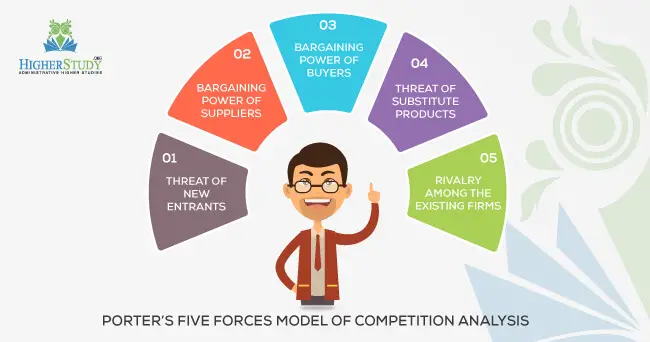Competitive Advantage Strategies in Business
Competitive advantage is the exceptional edge that allows an organization or business company to better deal with the marketplace and environmental forces than its competitors. It derives from strategies that lead to some uniqueness in the marketplace. It indicates a company’s competitive position that allows it to achieve higher profitability than its average. To develop a competitive advantage, a company should develop distinctive competencies and then use them to compete creatively in its markets.
Sources of Competitive Advantages:
The company has a competitive advantage wherever it has an edge over the competitors in attracting customers and defending against competitive forces. There are many sources of Competitive advantages:
- Having the best-made product on the market.
- Delivering superior customer service.
- Achieving a lower cost than competitors.
- Being in a more convenient geographical location.
- Proprietary technology.
- Features and styling with more buyer appeal.
- Shorter lead times in developing and testing new products.
- A well-known brand name and reputation.
- Providing buyers more value for money.
Managers need to recognize those winning business strategies are grounded in sustainable competitive advantage.
The capability of competitors to imitate a company’s distinctive competency needs to be given due consideration. If the competitors strongly commit to doing business in a particular way, they will not suddenly imitate a company’s innovation. In such a situation, its distinctive competency will be sustainable for a long. Frequent product innovation makes an industry’s environment dynamic. For example, the software industry/ electronics industry and PC industry are highly dynamic because of the high innovation rate. In such industries, competitive advantages are short-lived.
Duration of competitive advantage:
A question is often asked by managers: “What is the duration of competitive advantage?” How long it will sustain primarily depends on
- Buries to imitation
- The capability of competitors and
- The general dynamism of an industry’s environment.
‘Barriers to imitation’ create obstacles for the competitors to copy a company’s distinctive competencies easily. Competitors will always try to imitate a company’s resources and capabilities. Evidence indicates that capabilities are more difficult to imitate than resources. Of the resources, tangible resources are easier to imitate than intangible resources. There is, thus, a need to build up distinctive competence based on unique capabilities rather than on tangible resources. This would help the company enjoy the distinctive competence for a longer period of time.
How to Sustain Competitive Advantage?
Since achieving and maintaining a competitive advantage is the primary aim of competitive strategies, managers should undertake measures to sustain competitive advantage once they achieve. Managers can build sustainable competitive advantage by adopting the following measures. Such as:-
- Focusing on building blocks of competitive advantages
- Developing distinctive competencies
- Creating an environment of organizational learning
- Instituting continuous improvement mechanism
- Instituting best practices
- Overcoming barriers to change.
Focusing on Building Blocks of Competitive Advantages:
As stated earlier, a company has a sustained competitive advantage when maintaining a higher-than-industry-average profit rate over several years. This becomes possible when the company emphasizes the four generic building blocks of competitive advantage, such as:-
- Efficiency
- Quality
- Innovation and
- Customer responsiveness.

Because of its focus on these building blocks, Apple Computer Company enjoyed a sustained competitive advantage over a long period from 1987 to 1993. The generic strategies are called ‘generic’ because any organization can adopt them irrespective of its products. Superior efficiency enables a company to lower its costs; it allows it to lower costs and charges a higher price; superior customer responsiveness allows it to charge a higher price, and superior innovation can lead to higher prices or lower unit costs. Together, these four building blocks help a company create more value than its competitors. Thus, a company can enjoy a sustained competitive advantage.
Developing Distinctive Competencies:
Managers have to develop distinctive competencies in order to sustain a competitive advantage. When distinctive competencies develop, they help in improving performance in all the areas of four building blocks. Distinctive competencies should develop in all required areas – never in some areas at the cost of other important areas. Companies need to be balanced in their pursuit of distinctive competencies.
Creating an Environment of Organizational Learning:
Sustaining competitive advantages also requires a congenial environment in the organization that promotes learning within the organization. Learning organizations can keep themselves at the top of all competitors because they are always searching for knowledge. In seeking and disseminating knowledge, they learn from prior mistakes and improve their work-processes over time.
Instituting Continuous Improvement Mechanism:
Instituting continuous improvement mechanism or TQM and business process re-engineering. Continuous improvement of the quality of both products and services in sine-qua-non for sustaining competitive advantage over a longer period of time. Managers need to devise dynamic ways to improve quality on a continuous basis. Some organizations have been successful in their endeavor to improve quality through instituting the Total Quality Management (TQM) program and business process re-engineering.
Instituting Best Practices:
The adoption of ‘industrial best practices’ helps develop distinctive competencies and thereby sustain a competitive advantage. Organizations can benchmark the successful business-practices of other competitors/companies in other industries and then adopt them after necessary fine-tuning. Thus, they can build and maintain resources and capabilities essential to achieving excellence in efficiency, quality, innovation, and customer responsiveness.
Overcoming Barriers to Change:
Companies fail to sustain a competitive advantage because they are unable to adapt to changes in the organization. They need to overcome the resistance to change so that they can maintain a competitive advantage. Companies can overcome the barriers to change through providing effective leadership, necessary changes in organization structure, creating appropriate control systems, and involving employees in decision making.




